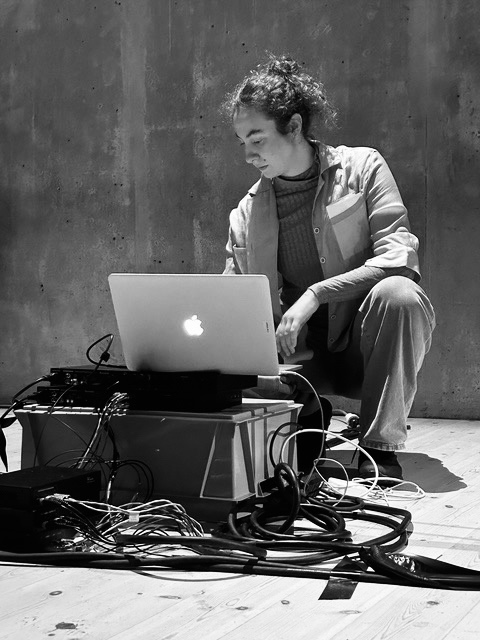SKH students strengthen the work of museums
It's hardly a surprise that the artists practising at SKH also contribute to art museums – like when choreographer Marie Fahlin’s doctoral project also included an exhibition at Marabouparken.
Less well known is how many people from SKH have also worked with other types of museums. Exhibitions on nature, technology and history have been enriched with interactive walks, animations, performances and installations. And the insights from SKH’s arts programmes can help museums to reflect on their programming in new ways.
For Emilia Sundberg, who is in her final year studying film sound in the Bachelor’s programme in Film and Media, it was obvious that she wanted to do her internship in a museum. Through contacts within the programme, she was given the opportunity to work at the Vasa Museum in Stockholm, and to think about how to design the sound environment there.
“The Vasa Museum is a place with a tangible and at times quite challenging sound environment, but with a powerful atmosphere,” says Emilia. “There are thousands of visitors and sounds that constantly bounce off each other. My role was very much about how to work with sound in such an environment. A common answer is to use apps on your phone, or portable sound guides, or sound showers, speakers that focus on a narrow area. But what else can be done?”
Emilia spent a lot of time recording the sounds that were naturally present in the large ship hall of the museum, often early in the morning and late at night when there were no visitors. This culminated in a sound walk with the museum staff inside the ship hall, where she presented a sound piece based on her field recordings.
An excerpt from Emilia Sundberg's sound work "hör du havet?", Vasa Museum, January 2025.
“A lot of people came, and it seems that many of the staff got something positive out of paying attention to the sound environment itself,” says Emilia. “They said things like ‘I became much more aware of this’ and ‘I just kept listening to this detail’, and reflected on their presence in the hall.”
A possible next step is to look at what possible additions can be made to the sound environment during the exhibition, without them getting lost in the cluttered acoustic environment.
“I think it could be small specific details with clear artistic intentions,” says Emilia. “Creaking, or the sound of a cannonball rolling.”
Circus objects in the forest
Artistic practices can bring different ways of knowing to exhibitions, explains SKH assistant professor Costanza Julia Bani, whose video installation Darkness Matters was shown at the Performing Arts Museum in December. The installation, which a small group of people can visit at a time, shows a vivid night sky and is meant to provoke thoughts about how light pollution affects our experience of the night.
“The Performing Arts Museum felt that the video installation’s dancing fireflies and the light of the Milky Way had choreographic qualities,” says Costanza. “By letting people sit still for so long and experience the night, they have the opportunity to slow down and meditate on what the night can contain.”
The installation will now go to the House of Science, which will show it in an inflatable dome for schoolchildren, in collaboration with Albanova.
Making visitors think has also been one of the main goals of Alva Harju Jansson, a second-year student in the Bachelor’s programme in Circus, who last autumn put on a performance at the National Museum of Science and Technology. She believes that there is great added value for visitors when you add artistic aspects to how you present information and knowledge.
“A technical museum can be very logic-based,” says Alva. “As a visitor, you are expected to look at an object and read about it. But with performance, you can activate the brain in a completely different way, help the neural pathways to draw new parallels, create empathy when you see a person moving along with an exhibited object.”
Alva Harju Jansson's performance at the NAVET Student Festival.
Alva’s performance was part of a student festival organised by NAVET, a collaboration between SKH, the Royal Institute of Technology and several other arts colleges. Through collaborations between researchers and students in science, technology and art, the idea is to enrich each other's fields with new ways of thinking.
Alva collaborated with Christine Nordqvist, an engineering student at the Royal Institute of Technology, to develop a new circus apparatus, Bark, which is linked to the National Museum of Science and Technology’s exhibition The Forest. Alva’s practice as a circus artist usually uses the Cyr wheel, a large circular steel tube that the performer rolls with and around in different ways. By trying a completely different shape of bent steel tube, inspired by the shapes of the forest, she has been developing new ways of moving – and it has helped her even when she has gone back to her regular equipment.
“There are a lot of circus apparatuses already, and it’s rare to have the opportunity to develop a new one in this way,” says Alva. “It's a different way of thinking about creativity – what if I change the whole set-up, is there something I can bring back with me later?”
The students are now continuing to work on Bark, including showing it in a performance at Stockholm Design Week in February. NAVET’s student festival at the National Museum of Science and Technology will return in the autumn, and SKH students are welcome to apply to participate again this year. There are still many exciting artistic opportunities in approaching other types of knowledge in a museum environment.

In her sound installation, Emilia Sundberg used specially designed speakers developed by SKH technician Max Edkvist. Photo: Emilia Sundberg

Emilia Sundberg works the mixer board for her sound installation. Photo: Tove Frambäck
Trailer for Costanza Julia Bani's video installation Darkness Matters.